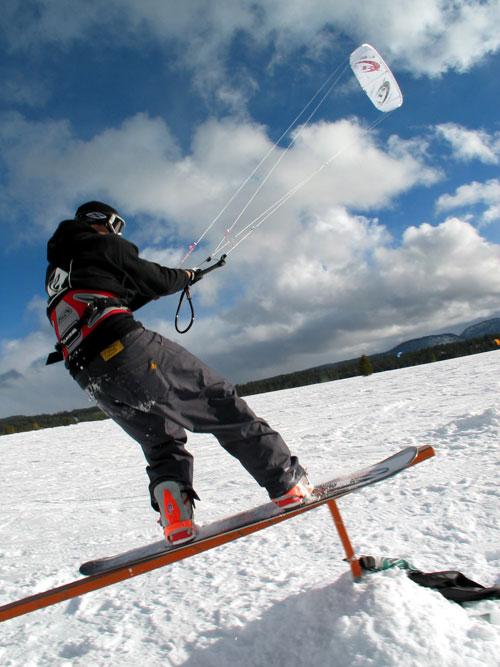
The riders at REAL have been snowkiting since 1999, so we are here to let you know the scoop. We have snow kiteboarded all across this country and on almost every type of snow or water kite available. There are a lot of kites out there that can work for snow kiteboarding, but the key is to dial yourself in with the products that will be best suited for your area and the type of riding that you want to do.
Getting Started in Snow Kiteboarding
Snow kiteboarding is far easier than kiteboarding in the water due to one reason, you are standing on land! Once you get your basic kite skills honed, you can strap on your snowboard or skis and get started.
The first thing that you need to do is get a good trainer kite and instructional DVD. The trainer kites that we recommend to all of our clients are the Slingshot B-Series. These “foil” kites are small enough that you can fly them on your own without any kite experience, and you can handle it. The Slingshot kites come complete with a 2-line bar and a safety system that is suitable for any age group to learn the basic kite skills safely.
With the assistance of the REAL “Zero 2 Hero” kiteboarding instructional DVD, you can fly your Trainer kite without taking lessons. The REAL “Zero 2 Hero” Instructional DVD clearly covers the safety steps that you will need to fly your kite on land. The main difference is that you will be wearing full snow gear rather than shorts and a t-shirt. Complete packages are available starting at $119, so learning to snow kiteboard is cheap and easy.
Get the digital copy of Zero 2 Hero for $9.99: Buy Now
What to Wear
There are a lot of misconceptions about what you have to wear to go snow kiteboarding. Most people think that they need to bundle up because it is cold, but it is actually quite different. When you go snow kiteboarding, you need to think about what you would wear if you were going running in the wintertime. Snow kiteboarding is an aerobic activity, so if you have too many clothes on then you will be really over heated.
REAL recommends riding in a thin wind-proof shell with a thin fleece under it and a pair of snow pants. It is important to have thin gloves with good grip. Even with the right clothing on you can expect to get wet from sitting in the snow or sweating while you are riding, so make sure to bring some extra warm and dry cloths to change into after your session.
What Kites Work Best
The riders at REAL have done the dirty work for you as far a choosing a snow kiteboarding kite that will work best for you. We started on ram air or “foil” kites in 1999 and have ridden almost every brand of inflatable and foil kite out there. The conclusions after years of testing are as follows:
1.Get a Good Trainer Kite to Start. You don’t need lessons if you get a small trainer to learn your basic kite skills. A kite like the Slingshot B3 will be a great kite to start, but it can also generate enough power to be able to ride on the snow.
2. Snow Foils work for Snow-Only Riding. Put your trainer kite on steroids with a Snow Foil Kite. A lot of people really like the idea of using foils in the snow because they are easy to use and work well. The riders at REAL have ridden every foil kite under the sun from the original F-Ones and Flexi Blades to the super high tech.
3. Ride an Inflatable Kite for the Snow and Water. Inflatable kites have superior performance to foil kites. If you don’t believe us then take a look at your local beach to see what type of kites people are riding. It is at least 10 to 1, inflatables to foil kites, because they work better for most people than foil kites.
The issue with using inflatable kites in the snow used to be durability, closing the valves in the snow, and kite relaunch. All of these issues have been resolved with modern kiteboarding kites. If these kites are strong enough to take a 20’ wave at the ZOO then it can definitely handle some crashes on the snow.
Where To Go?
Chasing wind in the winter can be a bit difficult because there are not cool forecast tools like www.ikitesurf.com to tell you what the wind is doing. The snow does not show the wind like the water does, so it can be difficult to pick a good spot to ride.
The primary thing you are looking for when you go snow kiteboarding is good clean wind. The best wind is going to be found in areas that are open to the wind like lakes or high plains. Kiteboarding in the mountains can be very challenging and dangerous due to updrafts and swirly, gusty wind.
The second thing you need is snow-covered terrain. Getting these two things to line up can be harder than you think. The main thing that you want is a non-rocky land surface. Frozen lakes are great as well as soccer or football fields. You only need about an inch of snow to ride on both of these surfaces. If you are going to be on terrain other than a lake or a field, you should make sure that there is a least one foot of snow pack, so you don’t destroy your board on rocks under the snow.
Get Out There!
This is the year that you become a kiteboarder. “If you don’t kiteboard now you will still suck this time next year” so there is no time like the present to learn! Learning on your own to snow kiteboard is a complete reality. Once you spend the winter snow kiteboarding, you can take a few lessons in the Spring and very easily become a water kiteboarder too.
For more info on Snow Kiteboarding or to order snow kite gear , call us toll free at 866-REAL-548.

